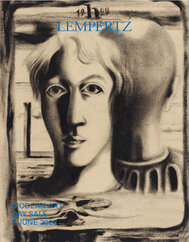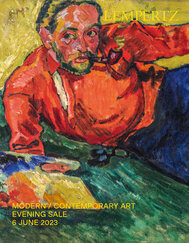Abstract Expressionism
The years of World War II marked a turning point in modern art history. The orientation of American artists to the stylistic development in the European art centres – in particular Paris – gave way to an increasing emancipation in the 1940s and 1950s. New York became the centre of a self-confident art scene, finding completely new, radical means of communication with Abstract Expressionism. Since the 1940s, it has also been summarised under the term ‘New York School’.
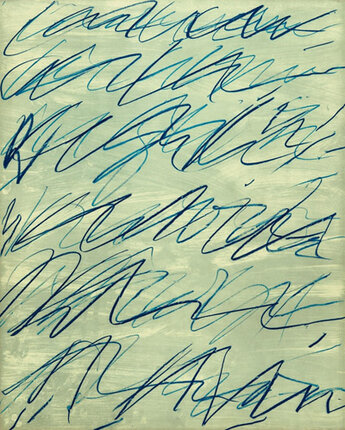
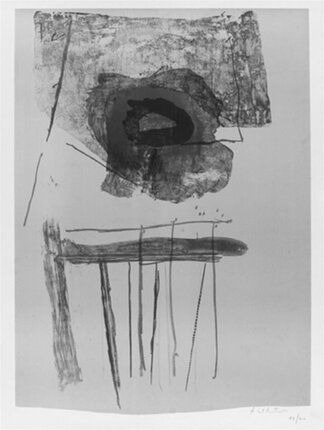
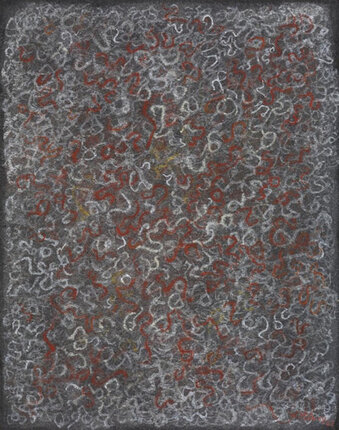
The attribution is reminiscent of the ‘École de Paris’ and references the fact that the art being created in New York took on an artistic guiding function in its colourfulness and vitality and sent groundbreaking impulses across to Europe.
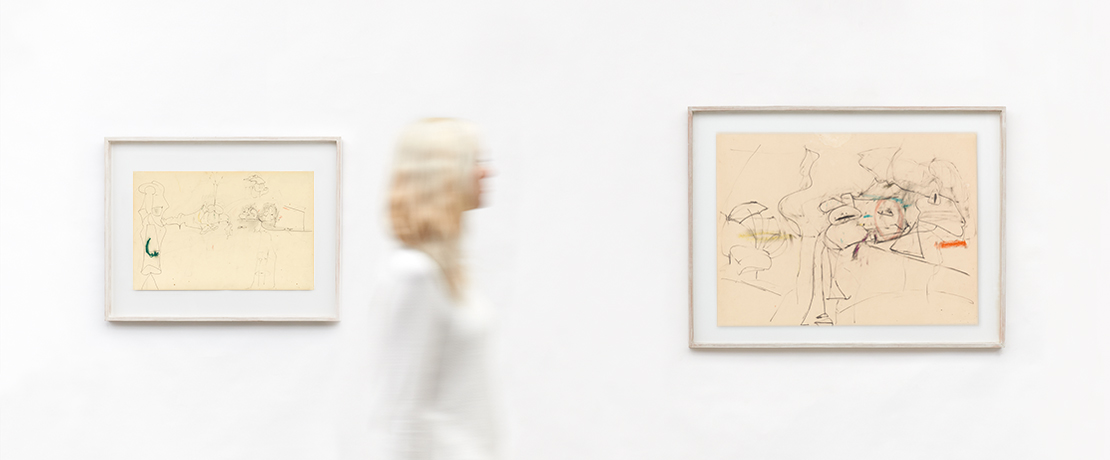
Untitled, 1946, Pencil and coloured chalk on handmade paper with watermark "Ingres d'Arches", 31,5 x 48,3 cm, Estimate: € 80.000 - 100.000;
Untitled, 1946-1948, Pencil and coloured chalk on drawing paper, 45,9 x 61,5 cm, Estimate: € 200.000 - 300.000
Abstract Expressionism - Table of contents
- Abstract Expressionism – Direct, spontaneous, and unfiltered
- Abstract Expressionism and Colour Field Painting
- Abstract Expressionism – Artists
- Abstract Expressionism – Arshile Gorky
- Abstract Expressionism – Helen Frankenthaler
- Abstract Expressionism – Cy Twombly
- Current auctions - Abstract Expressionism
- Our passed Abstract Expressionism-Auctions
- Abstract Expressionism-Auctions Prices
- Sell Abstract Expressionism - Object evaluation & Consignment
Abstract Expressionism – Direct, spontaneous, and unfiltered
In Abstract Expressionism, the process of painting becomes the decisive factor with the relative abandonment of the pictorial function. The artist translates his emotions onto the painting ground directly, spontaneously, and unfiltered, with the painterly gesture. The spiritedly applied gestural lines and colour swathes, as exemplified by Jackson Pollock’s Action paintings, issue from a purely subjective sentiment, the confrontation with one’s own fears, visions, and formative experiences. The subconscious and intuition underly the works, whereby they take up the working method of European Surrealism, the ‘écriture automatique’.
Abstract Expressionism and Colour Field Painting
Colour Field Painting emerged from Abstract Expressionism. The boundaries are fluid, so that many artists cannot be clearly assigned to one style. In its purest form, it is characterised by largely homogonous, juxtaposed fields of flat colour applied on large-format picture grounds.
The colour becomes the only pictorial subject by its simple presence. In contrast to the emotionally loaded treatment of colour of Abstract Expressionism, Colour Field Painting is characterised by an optical calming and uniformity but possesses a comparably impressive presence.
Abstract Expressionism – Artists
Works by Ashile Gorky, Helen Frankenthaler and Cy Twombly give an insight into the diversity of this significant era. These three artists each occupy decisive junctures in the development of Abstract Expressionism with their unique, pioneering oeuvre.
Abstract Expressionism – Arshile Gorky
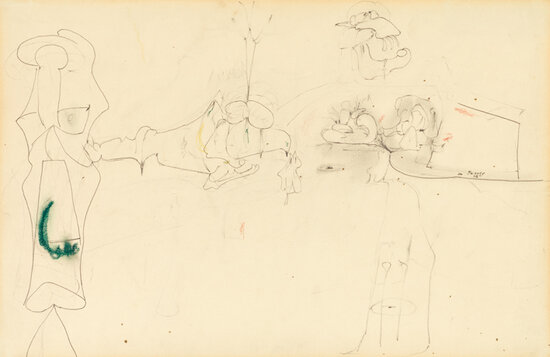
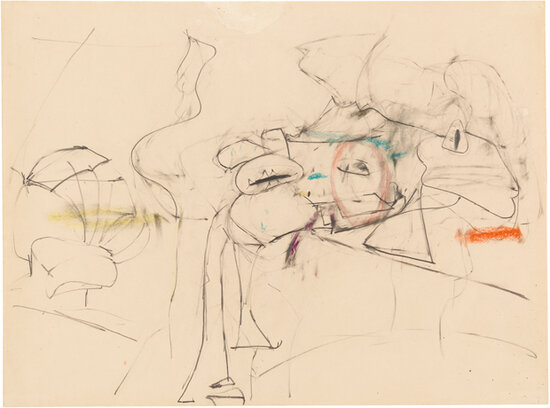
Ashile Gorky (1904-1948) - alongside Hans Hoffmann, Jackson Pollock and Willem de Kooning - is one of the most important representatives of the first generation of the New York School. Gorky, born Vosdanig Manoog Adoian, emigrated to the USA as a teenager to escape the genocide in Armenia.
Following his artistic interests, he initially trained himself. He settled in New York in 1924, taking on his pseudonym, and studied at the National Academy of Design at the Grand Central School of Art, where he later also taught. He first worked under the stylistic influences of Cézanne and Picasso and took part in a group exhibition of young artists at the Museum of Modern Art as early as 1930. One year later, the Mellon Gallery in Philadelphia presented his first solo exhibition.
From the end of the 1920s, Gorky oriented himself to Cubism; however, the first biomorphic forms inspired by Joan Miró and André Masson can be found in his cubist-like constructions. He became friends with Willem de Kooning, the same age as him, and they shared a studio. The Surrealists André Breton and Roberto Matta also become close friends in the 1940s, inspiring him to his personal abstract-surrealist style. He combined bright flecks of colour, created by dripping and running, with biomorphic forms of delicate lines. His works span a bridge from European art history – which he studied long, and intensively replicated – through Surrealism, and to the gesturally impulsive ductus of Abstract Expressionism.
Suffering greatly from cancer and the consequences of a car accident, Arshile Gorky took his own life in 1948.
Abstract Expressionism – Helen Frankenthaler
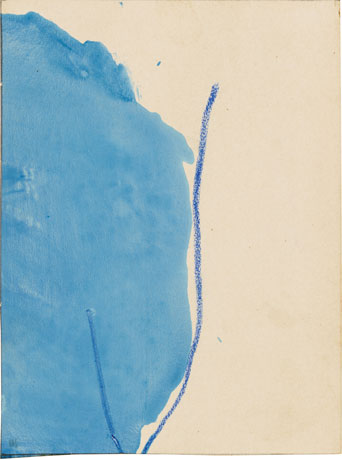
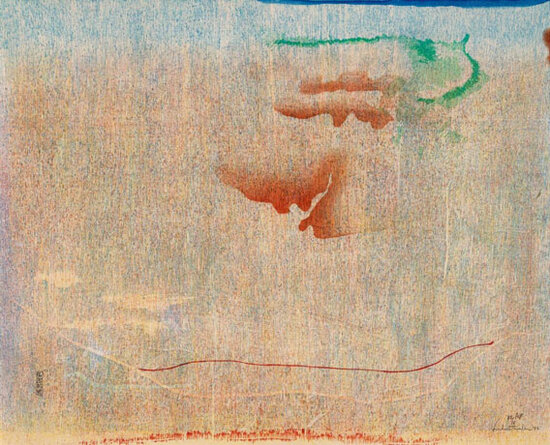
Helen Frankenthaler (1928-2011) is the most important trailblazer of Colour Field Painting; her work emerged from Abstract Expressionism and led to a pure work of coloured areas.
Frankenthaler is assigned to the second generation of the New York School. From 1945 to 1949, she studied at a private art college in Vermont and at the Art Students League of New York and subsequently became a private student of Hans Hofmann, the German-born painter, who with his New York Art School, exerted a considerable influence on the development of Abstract Expressionism and Colour Field Painting.
Frankenthaler made contact with the first painters of the New York School via the art critic Clement Greenberg. In the early 1950s, she found her own style which followed on from early works by Kandinsky but was significantly influenced by Jackson Pollock. In her personal form of Action Painting, she cultivated a lyrical, less dramatic mode of expression than her male colleagues. Through the soaking of unprimed canvases with thinned paint, the ‘soak stain method’, the artist achieved transparent-like colour fields with organic, abstract elements. Her painting method where colour and painting ground merge into one, was adopted by Morris Louis and Kenneth Noland.
In 1958, Frankenthaler married her painting colleague Robert Motherwell.
The Jewish Museum New York held her first retrospective in 1960. From the early 1960s, the artist used acrylic instead of oil paint for her painting, giving stronger contours and deeper colours, and also looked at print graphic techniques. Decisive sources of inspiration for her work were impressions of landscape and nature.
Frankenthaler taught at Yale and Princeton Universities and later worked as a sculptor and stage set designer.
Abstract Expressionism – Cy Twombly
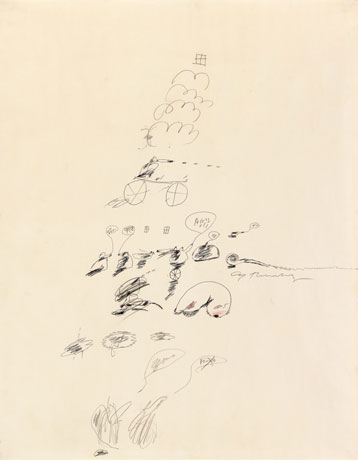
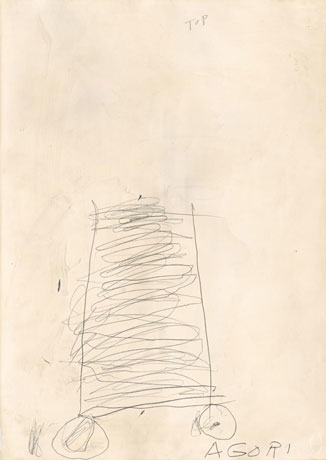
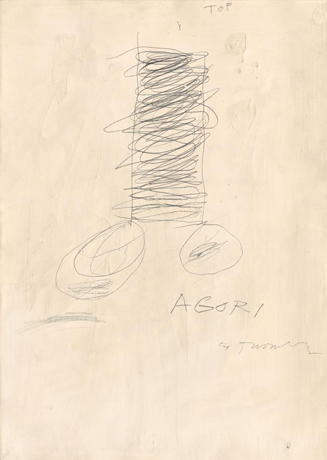
Cy Twombly (1928-2011) is one of the most famous representatives of Abstract Expressionism, but in his biographical and artistic history, takes on a special role.
Twombly studied at various high schools in Rome/Georgia, Boston, and his hometown of Lexington/Virginia before moving to New York for a fellowship at the Arts Students League where he had loose contact with the representatives of the New York School. He became friends with fellow student Robert Rauschenberg, at whose suggestion he attended courses at the Black Mountain College in North Carolina in 1951 and 1952. There he was taught by Robert Motherwell and Franz Kline.
A travel scholarship enabled Twombly to undertake an extended trip in 1952/53 through Southern Europe and North Africa, at times accompanied by Rauschenberg, and after his return, the artists shared a studio in New York for a short while and exhibited in the Stable Gallery.
Twombly increasingly relocated the focus of his life to Italy, and in 1960, moved with his family to Rome. That same year, the Leo Castelli Gallery in New York held an important solo exhibition. The artist travelled restlessly around the Mediterranean and North Africa in the years that followed, with themes from mythology, literature and natural history dominating his work.
The artist developed an unmistakeable graffiti-like pictorial language. In short, quick action processes, he placed filigree ciphers on the picture ground, reminiscent of lettering, and worked with delicate traces of colour and lineal abstract sketches. In doing so, he combined various techniques and created collages. Alongside his sometimes large-format paintings and drawings, Twombly photographed and developed three-dimensional objects.
Abstract Expressionism - More artists
The following artists contributed significantly to the development and popularity of Abstract Expressionism:
- Jackson Pollock (1912–1956)
- Willem de Kooning (1904–1997)
- Mark Rothko (1903–1970)
- Clyfford Still (1904–1980)
- Franz Kline (1910–1962)
- Lee Krasner (1908–1984)
- Robert Motherwell (1915–1991)
Current auctions - Abstract Expressionism
Auction 1224 - Day Sale - Modern Art
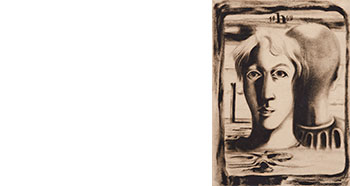
Auction
Wednesday, June 7
11 am: Lot 100 – 275
Preview
Thursday/Friday, 1/2 June, 10 am - 5.30 pm
Saturday, June 3, 10 am - 4 pm
Sunday, June 4, 11 a.m. - 4 p.m.
Monday, June 5, 10 a.m. - 5.30 p.m.
Vernissage
Wednesday, May 31, 6 pm
Berlin, Poststr. 22 (a selection)
Tuesday, May 23, 10 am - 9 pm
Wednesday, 24 May 10 am - 5 pm
Vernissage
Tuesday, May 23, 6 pm
Auction 1223 - Evening Sale - Modern Art
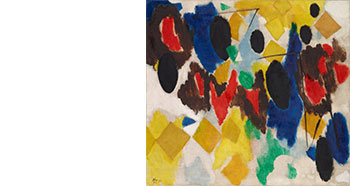
Auction
Tuesday, June 6
6 pm: Lot 1 – 97
Preview
Thursday/Friday, 1/2 June, 10 am - 5.30 pm
Saturday, June 3, 10 am - 4 pm
Sunday, June 4, 11 a.m. - 4 p.m.
Monday, June 5, 10 a.m. - 5.30 p.m.
Vernissage
Wednesday, May 31, 6 pm
Berlin, Poststr. 22 (a selection)
Tuesday, May 23, 10 am - 9 pm
Wednesday, 24 May 10 am - 5 pm
Vernissage
Tuesday, May 23, 6 pm
Our passed Abstract Expressionism-Auctions
- Auction 1212 - Day Sale - Modern Art
- Auction 1211 - Evening Sale - Modern Art and Contemporary Art
- Auction 1201 - Day Sale - Modern Art
- Auction 1200 - Evening Sale - Modern Art and Contemporary Art
- Auction 1188 - Day Sale - Modern Art
- Auction 1187 - Evening Sale - Modern and Contemporary Art
- Auction 1178 - Day Sale - Modern and Contemporary Art
Abstract Expressionism-Auctions Prices
A few examples of Abstract Expressionism prices auctioned in Lempertz auctions:
| Abstract Expressionism | Auction - Lot Nr. | Object | Price |
|---|---|---|---|
| Abstract Expressionism | Auction 1200 - Lot 11 | Helen Frankenthaler - Untitled | 113.400 € |
| Abstract Expressionism | Auction 1188 - Lot 273 | Mark Tobey - Ohne Titel | 3.125 € |
| Abstract Expressionism | Auction 1188 - Lot 275 | Mark Tobey - Cadre vert | 4.000 € |
| Abstract Expressionism | Auction 1177 - Lot 3 | William Nelson Copley - Untitled | 262.500 € |
| Abstract Expressionism | Auction 1177 - Lot 4 | William Nelson Copley - Untitled | 137.500 € |
Sell Abstract Expressionism - Object evaluation & Consignment
Do you own a work by a Abstract Expressionism artist and would like to sell it?
Have your work of art valued without obligation and free of charge.
Our experts will contact you with their assessment of your works/works of art as soon as possible.

